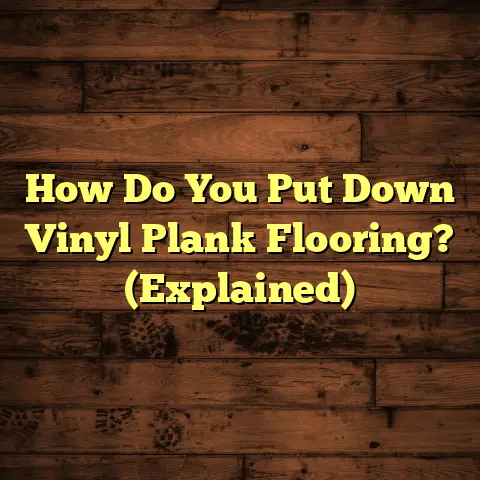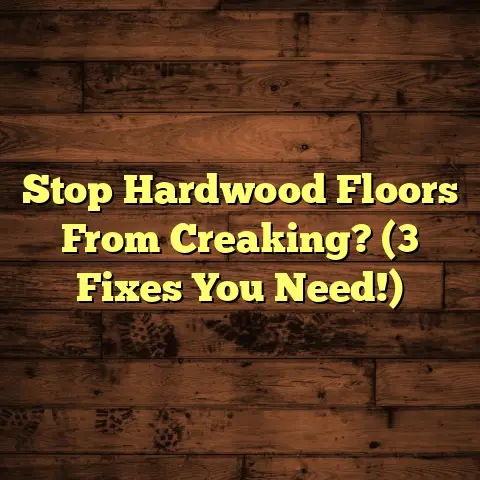Wood Flooring Moisture: Guide (2 Min Read!)
Okay, here we go! Let’s dive into the wild world of wood flooring moisture.
Wood Flooring Moisture: The Ultimate Guide (2 Min Read!)
Ever wonder what your wood floor really thinks about? Maybe it’s contemplating the meaning of life, or perhaps it’s just stressed about the humidity!
I’ve seen it all in my years as a flooring contractor. And believe me, wood floors have secrets. Especially when it comes to moisture.
Think of it like this: your floor is a living, breathing thing (well, not breathing exactly). And moisture is a big part of its life.
So, let’s get real about wood flooring moisture. I’m here to guide you through everything you need to know to keep your floors happy and healthy.
1. The Basics of Wood Flooring Moisture
What exactly is wood flooring moisture? Simply put, it’s the amount of water contained within the wood fibers of your floor.
Why does it matter? Because wood is hygroscopic, meaning it naturally absorbs and releases moisture from its environment.
Too much moisture, and your floor can warp, buckle, or even grow mold. Too little, and it can crack and splinter. It’s a delicate balance!
There are different types of moisture that can affect your floor:
- Ambient Humidity: The general moisture level in the air.
- Spills: Accidents happen, right?
- Leaks: Plumbing issues or appliance malfunctions.
I always tell my clients, wood flooring moisture is like a bad hair day for your floor. It just doesn’t look or feel right.
2. Sources of Moisture in Wood Flooring
So, where does all this moisture come from? Let’s break down the usual suspects.
-
Humidity Levels: This is a big one. High humidity can cause your floor to absorb excess moisture from the air.
I’ve seen homes where the humidity is so high, the floors practically sweat. Not a good look, trust me!
According to the EPA, indoor humidity should be between 30-50% to prevent mold growth and other moisture-related issues. (Source: EPA Indoor Air Quality)
-
Spills and Accidents: We’re talking about everything from spilled drinks to pet accidents. A pet water bowl gone rogue is a classic.
I remember one time, a client’s dog decided the hardwood floor was the perfect place to “rearrange” his water bowl. Let’s just say, it wasn’t pretty.
-
Leaks from Plumbing or Appliances: A leaky faucet or a faulty dishwasher can wreak havoc on your wood floors.
I had a client who discovered a slow leak under their kitchen sink. By the time they noticed, the wood floor was already starting to warp. Cost them a fortune to repair!
You know, I always say, “An ounce of prevention is worth a pound of cure,” especially when it comes to plumbing.
3. The Effects of Moisture on Wood Flooring
Now, let’s talk about what happens when your wood floor gets too much moisture. It’s not a pretty picture.
-
Warping: This is when the wood starts to bend and distort. Imagine your floor turning into a funhouse mirror!
I like to compare warped wood to a rollercoaster ride – thrilling, but not ideal for your living room.
-
Buckling: This is when the wood starts to lift up from the subfloor, creating unsightly humps and bumps.
I’ve seen floors buckle so badly, you could trip over them! Not exactly the welcoming atmosphere you want in your home.
-
Mold Growth: This is the worst-case scenario. Mold not only damages your floor, but it can also pose a health risk to you and your family.
I once had a client who didn’t realize they had a leaky pipe under their floor. By the time they called me, mold had taken over. It was a major cleanup job!
According to the CDC, mold can cause a variety of health problems, including respiratory infections and allergic reactions. (Source: CDC Mold Information)
4. Measuring Moisture Levels in Wood Flooring
Okay, so how do you know if your floor has too much moisture? The answer is a moisture meter.
These handy tools measure the moisture content of wood. There are two main types:
- Pin Meters: These have two pins that you insert into the wood to get a reading.
-
Pinless Meters: These use electromagnetic waves to measure moisture without damaging the wood.
I prefer pinless meters because they’re less invasive. No one wants to poke holes in their beautiful wood floor!
Here’s a step-by-step guide on how to use a moisture meter:
- Calibrate the Meter: Make sure your meter is properly calibrated according to the manufacturer’s instructions.
- Select a Test Area: Choose a few different spots on your floor to test. Pay attention to areas that seem damp or discolored.
- Take a Reading: Follow the meter’s instructions to take a reading. Write down the results.
- Compare to Ideal Levels: Compare your readings to the ideal moisture content range for your type of wood flooring.
I always tell my clients, using a moisture meter is like conducting a scientific experiment gone wrong. Your floor becomes the test subject!
5. The Ideal Moisture Levels for Wood Flooring
So, what’s the magic number? The ideal moisture content range for wood flooring is generally between 6-12%.
However, this can vary depending on the type of wood, the climate you live in, and the time of year.
Here’s a general guideline:
- Solid Hardwood: 6-9%
- Engineered Hardwood: 6-12%
Think of it like a “good moods” versus “bad moods” scale. Too dry, and your floor is grumpy and cracked. Too wet, and it’s warped and moldy. You want to keep it in the happy zone!
It’s crucial to consider your local climate. For example, if you live in a humid area like Florida, you might aim for the higher end of the range (closer to 12%).
I always recommend consulting with a flooring professional to determine the ideal moisture content for your specific situation.
6. Prevention Tips for Moisture Issues
Okay, let’s talk about how to keep your wood floors happy and dry. Here are some practical tips to prevent moisture issues:
-
Use Dehumidifiers: If you live in a humid area, a dehumidifier can help to lower the moisture level in your home.
I tell my clients to “give their floors a spa day” by maintaining proper humidity levels. Think of it as a relaxing retreat for your wood!
-
Regular Maintenance and Cleaning: Clean up spills immediately and avoid using excessive water when mopping.
I recommend using a microfiber mop and a wood floor cleaner specifically designed for hardwood.
-
Ensure Proper Ventilation: Make sure your home is well-ventilated, especially in areas prone to moisture, like bathrooms and kitchens.
Open windows and use exhaust fans to circulate air.
-
Check for Leaks Regularly: Inspect your plumbing and appliances for leaks on a regular basis. A small leak can turn into a big problem if left unchecked.
I always tell my clients, “Be a leak detective!” The sooner you find a leak, the better.
-
Use Area Rugs: In high-traffic areas or areas prone to spills, use area rugs to protect your wood floors.
Rugs can also add a touch of style and comfort to your home. It’s a win-win!
7. What to Do If You Encounter Moisture Issues
Even with the best prevention efforts, moisture issues can still arise. Here’s what to do if you suspect your floor has a problem:
-
Identify the Source of Moisture: The first step is to figure out where the moisture is coming from. Is it a spill, a leak, or high humidity?
I always tell my clients, “Be a moisture detective!” Follow the clues and find the culprit.
-
Use Fans or Dehumidifiers: If the moisture is localized, use fans or dehumidifiers to help dry out the area.
I recommend placing fans directly on the affected area to promote air circulation.
-
Remove Standing Water: If there’s standing water, remove it immediately with a wet/dry vacuum or towels.
The longer water sits on your floor, the more damage it can cause.
-
Consult Professionals if Necessary: If the moisture issue is severe or you’re not sure how to handle it, consult with a flooring professional.
I’ve seen cases where homeowners tried to fix moisture problems themselves, only to make things worse. Sometimes, it’s best to call in the experts.
Think of it as “rescuing” your floor from a moisture disaster. We’re here to help!
8. Conclusion
So, there you have it! Everything you need to know about wood flooring moisture. It’s a complex topic, but with the right knowledge and tools, you can keep your floors looking beautiful for years to come.
Remember, your wood floors are a valuable investment. Taking care of them is worth the effort.
I hope this guide has been helpful and informative. And remember, while your floors may have their ups and downs, with the right care, they can keep on dancing through life!
Just keep them dry and happy, and they’ll thank you for it. Now, go forth and conquer the world of wood flooring moisture!





